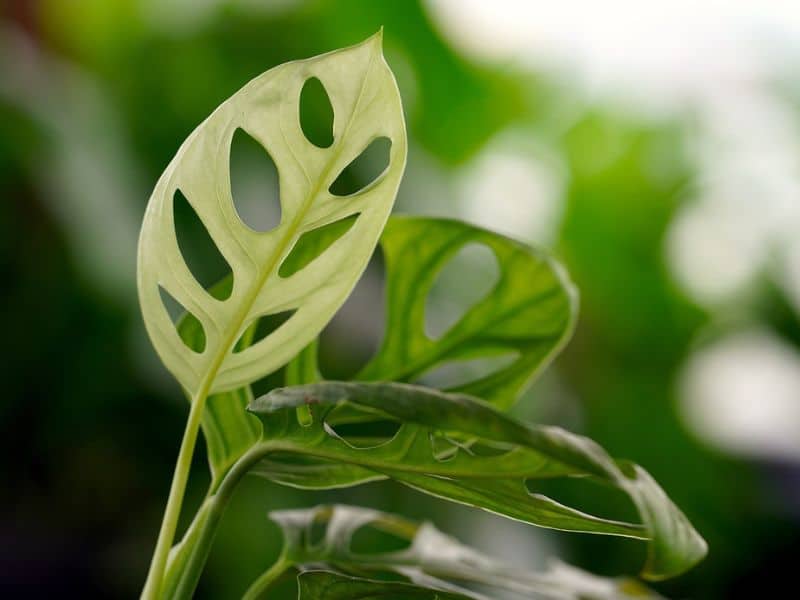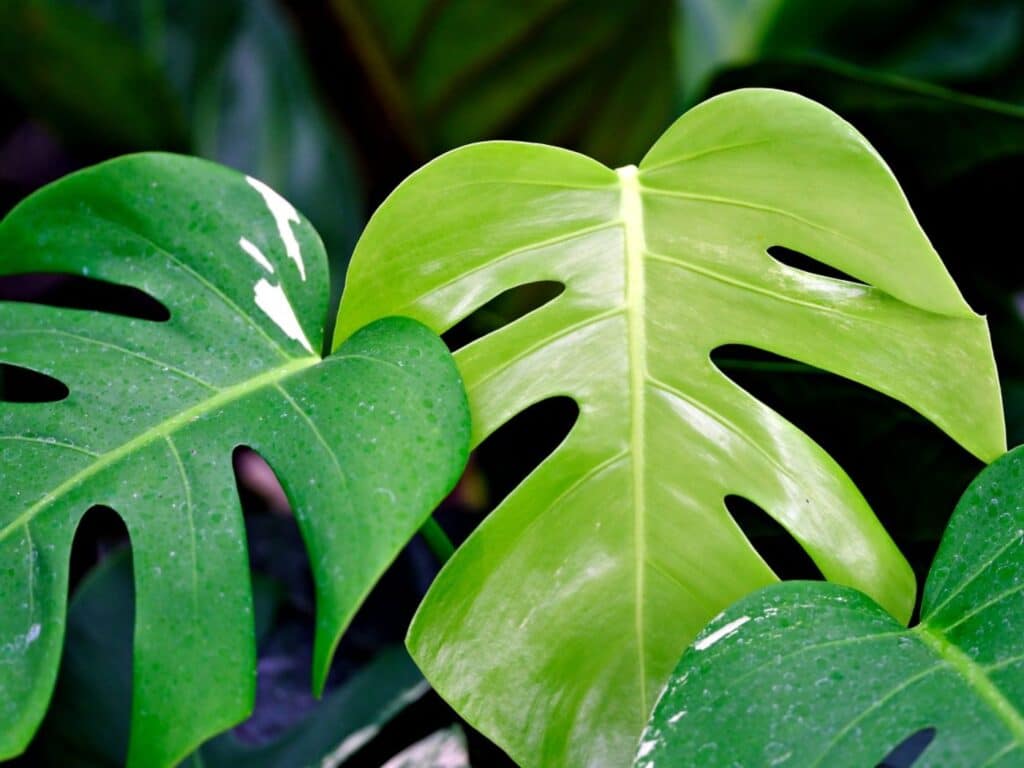You’ve nurtured your monstera with the utmost care, watching it grow, marveling at its lush, vibrant leaves. But then, you notice a change – a yellow tinge creeping into the leaves that once symbolized vitality and growth.
It’s disheartening, isn’t it? Yellowing leaves can be the first sign that your beloved plant is in distress, signaling potential issues that need your immediate attention.
Understanding why your monstera leaves are turning yellow is the first step towards reviving your plant’s health. Whether it’s due to overwatering, lack of nutrients, or inadequate light, identifying the root cause is crucial.
This article aims to guide you through the common reasons behind this issue and provide practical solutions to help your monstera thrive once again. Let’s embark on this journey together to ensure your monstera remains a vibrant centerpiece in your home.
Understanding Monstera Leaves Turning Yellow
The Natural Aging Process
Older leaves on your monstera turning yellow is just nature’s way of saying it’s time to let go. This natural cycle allows the plant to focus its energy on newer, healthier growth.
If you notice older leaves at the bottom yellowing and falling off occasionally, don’t sweat it; your plant’s just doing its thing. Keeping an eye on which leaves are turning yellow helps distinguish normal aging from more serious issues.
Signs of Stress in Monsteras
When your monstera shows signs of stress, the yellowing leaves are its distress signals. Overwatering is a common culprit, leaving the roots too soggy and unable to breathe.
In contrast, underwatering deprives your monstera of needed hydration, leading to a similar yellow appearance. Light levels too play a role; too much sun scorches leaves, while too little leaves them yearning for more.
Finally, a lack of nutrients can starve your plant, causing its leaves to turn yellow as a cry for help. Monitoring these factors closely allows you to adjust care routines and keep your monstera thriving.
Common Causes of Yellowing Leaves on Monstera Plants

Your monstera’s leaves turning yellow can feel like a bad mystery novel, minus the entertainment value. Thankfully, solving this foliage whodunit is easier than you may well think. Let’s dive into the common culprits and turn that thumb of yours greener in the process.
Overwatering and Underwatering Issues
Yes, your monstera can be as picky as a toddler at mealtime when it comes to water. An overwatered monstera suffers from too much water, and the roots can’t breathe, leading to root rot. This nasty condition prevents the roots from absorbing nutrients and water effectively, causing the leaves to turn yellow.
On the flip side, too little water causes the plant to dry out, leading to stressed leaves that also turn yellow. Find that Goldilocks zone of watering – not too much, not too little, just right. Stick your finger 2 inches into the soil; if it’s dry, it’s time to water.
Sunlight Exposure and Leaf Burn
Monsteras love a good tan, but not too much. Think of them as enjoying a sunny day with shades on. Direct sunlight can be too harsh, leading to leaf burn, with leaves first turning yellow before possibly getting crispy. Indirect, bright light is their jam.
A nice spot where the sun’s rays don’t directly hit the leaves but provide ample light is the sweet spot. If your plant sits by a sunny window, consider sheer curtains to diffuse the light and prevent yellow leaves.
Nutritional Deficiencies
Imagine trying to grow strong without enough food. That’s your monstera without the right nutrients. A lack of essential elements, particularly nitrogen, can lead to yellowing leaves. Nitrogen is crucial for healthy, green foliage and growth.
If you suspect your plant isn’t getting enough to eat, a balanced, water-soluble fertilizer can make a world of difference. However, like a kid with candy, moderation is key. Over-fertilizing can overwhelm your plant, leading to—you guessed it—more yellow leaves.
By addressing these issues, you’ll become a monstera maestro in no time. Yellow leaves may well be frustrating, but they’re often just your plant’s way of asking for help. Listen closely, and you’ll crack the case of the yellowing leaves, ensuring your monstera continues to thrive.
Diagnosing Your Monstera Plant
Assessing Watering Habits
Correct watering is crucial for Monstera plants. If your Monstera’s leaves are turning yellow, first look at how often you’re watering. These plants prefer their soil to dry out slightly between waterings.
If the soil feels soggy or if you can’t remember your last watering day, you may well have gone a bit overboard. On the flip side, if the soil feels as dry as a desert, it’s time to hydrate. Finding that sweet spot is key, so aim for consistency in your watering schedule.
Checking Light and Location
Sunlight, or the lack thereof, plays a significant role in the health of your Monstera. Too much direct sunlight can scorch leaves, leaving them yellow and fried, while too little light can lead to pale, yellow leaves craving sunshine.
The ideal spot offers bright, indirect light—it’s like a cozy reading nook for your plant. Evaluate your Monstera’s current location. If it’s basking in direct sunlight or hidden in a shadowy corner, consider moving it to a better-suited spot.
Soil Quality and Root Health
Lastly, don’t forget to check what’s happening below the surface. Soil quality and root health are fundamental to preventing yellow leaves. A good, airy potting mix allows roots to breathe and efficiently absorb nutrients. If the soil is compacted or poor in quality, your Monstera will struggle.
Additionally, inspect the roots—if they’re brown and mushy, root rot could be the culprit.
This usually occurs from overwatering but fret not, it’s fixable. Repotting your Monstera into fresh soil and snipping off any rotten roots can often save your green friend.
Steps to Revive a Monstera with Yellow Leaves
Yellowing leaves on your monstera can turn your indoor jungle dreams into a puzzling scenario pretty quickly. Let’s dive into some actionable steps to get your green friend back on track.
Adjusting Watering Techniques
Monstera plants are like that friend who never knows if they’re thirsty or not. You’ve got to check the soil’s moisture level before giving it a drink. Stick your finger about an inch deep into the soil; if it’s dry, it’s time to water.
If it’s still damp, hold off on watering for a few days. Overhydration is a common misstep, so aim for moderation. Consistency is key, and in this case, it may well just prevent those leaves from turning yellow.
Optimizing Light Conditions
Light to a monstera is like coffee to us; getting the right amount makes all the difference. These plants prefer bright, indirect light. Think of a spot in your home that’s bathed in sunlight, but not directly under the blistering rays.
Too much sun leads to sunburn, and too little results in a pale monstera, yearning for sunlight. Balancing this light exposure is crucial. If you notice the yellow leaves are on the side facing away from the light, consider this a sign to rotate your plant periodically for even growth and coloration.
Fertilizing and Repotting Tips
Monstera, much like a growing teenager, needs the right nutrients to thrive. If your monstera’s leaves are turning yellow, this may well be a cry for help — or rather, nutrients.
A balanced, water-soluble fertilizer applied monthly during spring and summer does wonders. But don’t go overboard; too much love in the form of fertilizer can harm it. Also, as monsteras grow, they may well outgrow their pots. If the roots are circling the bottom or poking out of the drainage holes, it’s time for a new home.
Choose a pot that’s about 2 inches larger in diameter than the old one. This not only provides new space for roots to explore but also fresh soil which can invigorate your plant.
Reviving a monstera with yellow leaves doesn’t have to be a chore. With these simple adjustments in watering, light exposure, and nutrition, you’ll likely see a turnaround in your plant’s health.
Remember, plants communicate through their leaves, so keep an eye out for those tell-tale signs and act accordingly. Your monstera will thank you with lush, green foliage that’s sure to enliven any space.
Preventative Measures for Healthy Monsteras
Routine Care Schedule
Creating a consistent care schedule is paramount for your monstera’s health. Water your plant when the top inch of soil feels dry to the touch, but avoid letting it sit in water, as this can lead to root rot. Monsteras benefit from bright, indirect light, so positioning them near a window where direct sunlight doesn’t reach works wonders.
Lastly, fertilize your monstera monthly during the growing season with a balanced, water-soluble fertilizer to support its nutritional needs.
Monitoring Plant Environment
Keeping an eye on the environment where your monstera resides can make a significant difference in its well-being. Humidity plays a crucial role, as these plants thrive in more humid conditions.
Consider using a humidifier or placing a water tray nearby to increase moisture in the air. Temperature fluctuations can stress your monstera, so aim to keep the room temperature between 65°F and 85°F.
Remember, each monstera has its preferences; observing and adjusting the environment to meet these needs can help prevent yellowing leaves and promote vibrant growth.
Frequently Asked Questions
Why do monstera leaves turn yellow?
Overwatering, lack of nutrients, inadequate light, and natural aging are common reasons. Other causes include underwatering, excessive sunlight, and nutritional deficiencies.
How can I prevent my monstera leaves from turning yellow?
To prevent yellowing leaves, ensure a consistent care schedule, monitor environmental factors like humidity and temperature, and provide proper watering, lighting, and fertilization.
Can overwatering and underwatering cause the same symptoms in monstera plants?
Yes, both overwatering and underwatering can lead to yellowing leaves in monstera plants. It’s crucial to find a balanced watering schedule specific to your plant’s needs.
How does sunlight exposure affect monstera plants?
Inadequate sunlight can cause yellowing leaves due to lack of energy for photosynthesis. However, too much direct sunlight can also harm the plant, leading to faded or scorched leaves.
Are nutrient deficiencies a common issue for monstera plants?
Yes, monstera plants can show signs of yellowing leaves due to nutrient deficiencies, particularly a lack of essential elements like nitrogen, phosphorus, and potassium. Proper fertilization can address this issue.
Read more:







